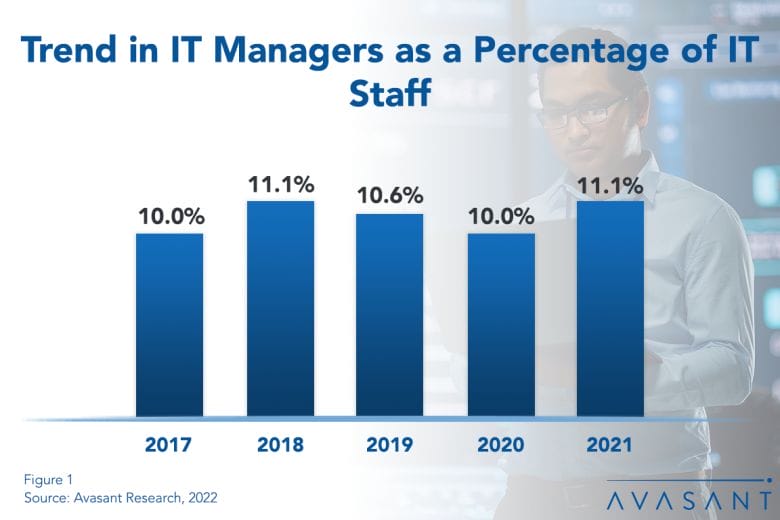Finding the golden ratio of IT management staffing has always been important to any organization. But, the continued adoption and implementation of cloud-based solutions and SaaS has changed roles and responsibilities for the IT group. More responsibility is being given to staff members in individual teams as more processes are automated. As IT becomes more strategic and less about “keeping the lights on” IT managers also need to be plugged into enterprise strategy.
In recent years, the median percentage of managers has shown some volatility. As shown in Figure 1 from the full report, IT Management and Administration Staffing Ratios, the ratio of IT management positions to total IT staff is 11.1% at the median in 2021, compared with 10.0% in 2020.

There is a natural cycle of staffing changes that is part of the changing IT organization. The cloud transformation is leading many IT organizations to shed support staff that has previously been needed to maintain the infrastructure. As these groups shrink or hold steady as the organization grows, other roles naturally make up a larger percentage of the total. Of course, eventually, as companies shed staff, they need to shed managers, as well. But companies are also using the savings from the cloud transformation to add more business-savvy personnel who also need to be managed. Put simply, as IT staffs are in transition, so are IT managers.
“This particular staffing ratio swings between 10% and 11%,” said Reneece Sterling, research analyst for Computer Economics, a service of Avasant Research, based in Los Angeles. “As companies shift to adopt cloud-based solutions and SaaS operational models, the staffing demand is increased for the initial phases of deployment. However, once these solutions are fully in place, there is a gradual reduction in the number of staff needed and, in turn, IT managers.”
This report examines how many IT managers a well-run IT group typically requires, along with staffing metrics for two related administrative functions: IT executives and managers, IT finance and vendor management personnel, project managers, and administrative support personnel. We define these categories as follows:
-
- IT Managers and Executives: IT managers are individuals whose primary job function is to manage people. We group all IT management levels into a single job function, including IT executives. First-level managers who are primarily “doers” (that is, managers in name only) are not counted as managers, but rather fall under the function that they supervise.
- IT Finance, Vendor Management, Procurement: These are individuals whose primary job function within the IT organization is related to finance, accounting, budgeting, procurement, vendor contracts, or vendor management.
- Administrative Support: Clerical/administrative personnel are individuals who do not have managerial responsibilities but support IT managers and other IT staff functions.
To benchmark IT management, we use two metrics: IT managers as a percentage of the IT staff and users per IT manager. We provide metrics for small, midsize, and large organizations. To provide further perspective, we consider the five-year trend in IT managers as an average percentage of the IT staff. We also report metrics for IT finance and administrative support staff.
This Research Byte is based on our report on this subject, IT Management and Administration Staffing Ratios. The full report is available at no charge for Computer Economics clients, or it may be purchased by non-clients directly from our website (click for pricing).



